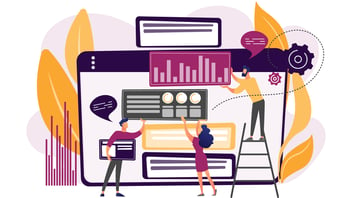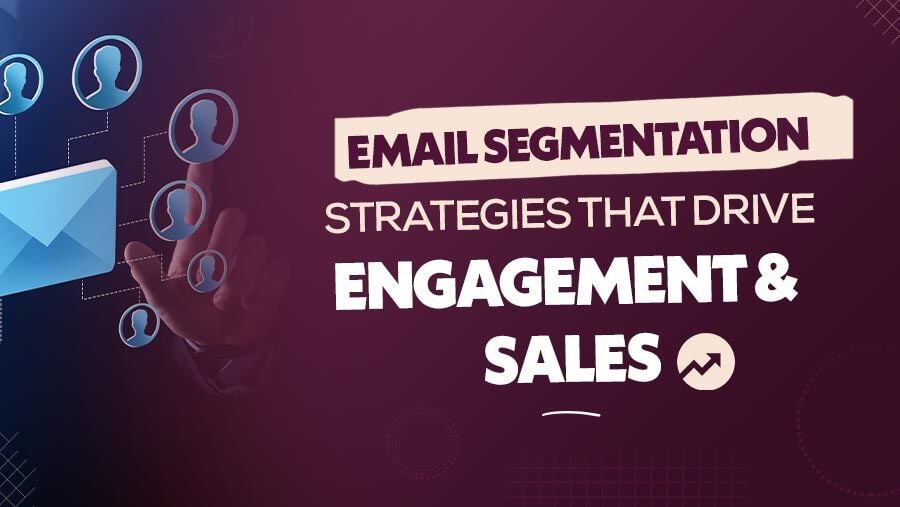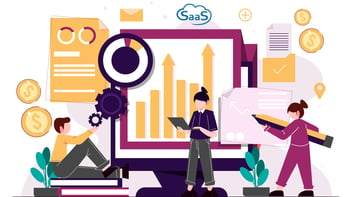
Email Segmentation Strategies That Drive Engagement & Sales
Considering the crowded digital marketing approaches, sending the same email to your entire database is no longer an effective strategy.
According to Campaign Monitor, marketers who used segmented campaigns noted as much as a 760% increase in revenue—compelling evidence that email segmentation strategies deserve your attention.
Here’s a guide to equip B2B marketers with practical approaches to segment your audience effectively. Also way to boost engagement metrics, and ultimately drive more sales through targeted communication.
Why Email Marketing Segmentation Strategy Is Critical for B2B Success
The evolution of email marketing strategy has transformed dramatically from the early days of mass email blasts to today's sophisticated, targeted communications. Modern B2B buyers expect personalized interactions that address their specific pain points, challenges, and business objectives.
Research from Mailchimp reveals that segmented email campaigns achieve 14.31% higher open rates and 100.95% higher click-through rates compared to non-segmented campaigns. Additionally, DMA reports that segmented and targeted emails generate 58% of all revenue for marketers who implement this strategy.
For B2B companies specifically, the financial impact is significant:
- Campaigns done with email marketing segmentation strategy reduce customer acquisition costs by up to 50% (Forrester)
- Targeted emails drive 18x more revenue than broadcast emails (Jupiter Research)
- 77% of ROI comes from segmented, targeted, and triggered campaigns (DMA)
Beyond the impressive metrics, segmentation helps maintain list hygiene, improve deliverability, and build stronger relationships with prospects and customers by demonstrating that you understand their unique business needs.
Understanding Your B2B Audience: The Foundation of Effective Email Segmentation
B2B audience segmentation differs significantly from B2C approaches. While consumer marketing often focuses on demographic data like age and gender, B2B segmentation must consider the complexity of organizational buying processes and multiple stakeholder involvement.
The B2B buying committee challenge is particularly noteworthy—according to Gartner, the typical buying group for a complex B2B solution involves 6-10 decision-makers. Each stakeholder approaches the purchase with different priorities, concerns, and evaluation criteria.
To build effective email segments to boost email deliverability, start by creating detailed ideal customer profiles (ICPs) that account for:
- Industry-specific challenges and terminology
- Organizational structures and decision-making processes
- Common technology ecosystems and integration requirements
- Regulatory and compliance considerations unique to each vertical
With these foundational elements in place, you're ready to implement advanced segmentation strategies that will transform your email marketing results.
10 Powerful Email Segmentation Strategies to Boost Email Deliverability
1. Industry-Based Segmentation
Segmenting your audience by industry allows you to speak directly to sector-specific challenges and opportunities. According to the Demand Gen Report, 76% of buyers expect content that speaks directly to their industry's needs.
Implementation Tips:
- Research industry-specific terminology and pain points
- Highlight relevant case studies from the same vertical
- Address industry regulations and compliance requirements
- Reference industry benchmarks and performance metrics
2. Company Size/Revenue Segmentation
Enterprise organizations and SMBs have fundamentally different buying processes, budget considerations, and implementation requirements. Segmenting by company size ensures you're addressing these differences appropriately.
Key Considerations:
- Enterprise communications typically emphasize scalability, integration capabilities, and enterprise-grade security
- SMB messaging focuses on ease of implementation, quick ROI, and affordability
- Mid-market companies often respond to messages about growth capabilities and competitive advantages
According to Aberdeen Group, 75% of enterprise buyers prefer content that demonstrates understanding of their specific business size and complexity, making this segmentation approach particularly valuable for complex B2B sales.
3. Type of Audience Segmentation based on Buyer Stage
Different content resonates at different stages of the buyer journey. McKinsey research indicates that B2B buyers complete 70% of their journey before ever engaging with sales, making journey-based email segmentation essential.

By delivering the right content at the right time, journey-based segmentation accelerates the path to purchase while providing genuine value at each stage.
4. Role-Based Segmentation
Different stakeholders evaluate solutions through different lenses. Segmenting by role allows you to address the specific concerns of each decision-maker or influencer.
- C-Suite Executives prioritize strategic impact, ROI, and competitive advantage. Their emails should be concise with executive summaries and business case elements.
- Mid-Level Management focuses on implementation challenges, team productivity, and departmental KPIs. They need more detailed information about features and specific use cases.
- End-Users care about ease of use, time savings, and practical application. Communications should emphasize user benefits and support resources.
Research from Salesforce indicates that role-targeted content generates 42% higher conversion rates compared to generic messaging.
5. Engagement-Based Segmentation
Behavioral data provides powerful insights for segmentation. By monitoring how contacts interact with your emails, website, and content, you can create highly responsive segments.
Active Subscribers (opened or clicked in last 30 days):
- Send more frequent communications
- Introduce advanced topics and solutions
- Include direct calls-to-action
Moderately Engaged (opened in last 90 days):
- Re-engagement campaigns with high-value content
- Surveys to better understand their interests
- Content that addresses common obstacles
Dormant Subscribers (no engagement in 90+ days):
- Re-permission campaigns
- "We miss you" messaging with special offers
- Content focused on recent innovations or success stories
According to Marketo, engagement-based segments can improve click-through rates by up to 250% compared to non-segmented campaigns.
6. Product Interest Segmentation
Website tracking and content consumption patterns reveal what products or solutions interest your prospects most. This behavioral data creates natural segmentation opportunities.
Implementation Approach:
- Track content consumption by topic/product
- Identify patterns of interest based on multiple interactions
- Develop product-specific nurture sequences
- Include cross-selling opportunities for complementary solutions
Research from DemandGen Report shows that leads nurtured with targeted content based on interest produce a 20% increase in sales opportunities.
7. Geographic Segmentation
Location-based segmentation extends beyond simple language preferences to address regional business practices, regulations, and cultural considerations.
Key Benefits:
- Ensures compliance with regional email regulations (GDPR, CCPA, etc.)
- Optimizes send times for higher open rates (20% improvement according to MailChimp)
- Addresses regional business challenges and priorities
- Customizes event invitations for local opportunities
Global B2B organizations can significantly improve engagement by recognizing and respecting regional differences in their email communications.
8. Purchase History Segmentation
Existing customers represent your most valuable segment. According to Bain & Company, increasing customer retention by just 5% can increase profits by 25-95%.
Effective Strategies:
- Create renewal reminder sequences
- Develop upsell campaigns based on complementary products
- Share advanced usage tips to improve adoption
- Provide early access to new features or solutions
Customer purchase history reveals patterns that help predict future needs, creating natural opportunities for targeted email campaigns.
9. Technology Stack Segmentation
For B2B technology companies, understanding a prospect's existing technology ecosystem creates powerful segmentation opportunities. According to Gartner, integration capabilities are among the top three decision factors for enterprise software purchases.
Applications:
- Highlight specific integrations with technologies they already use
- Address compatibility considerations proactively
- Share success stories from companies with similar technology stacks
- Provide migration pathways from competitive solutions
This segmentation strategy demonstrates deep understanding of the prospect's environment and reduces perceived implementation risks.
10. Event-Based Segmentation
Interactions with your company create natural segmentation opportunities. Event attendance, webinar participation, or content downloads all indicate specific interests and engagement levels.
Example Workflows:
- Post-Webinar Sequence: Follow up with additional resources, answers to common questions, and next steps based on webinar topic
- Trade Show Follow-Up: Send industry-specific messaging referencing conversations at the event
- Demo Attendees: Provide implementation considerations, customer success stories, and technical documentation
Organizations using event-based segmentation see 3-5x higher conversion rates compared to generic follow-up approaches, according to Demand Metric research.
Implementation: Building Your Email Segmentation Strategy
Developing an effective segmentation strategy requires methodical planning and execution. Follow this process to implement segmentation successfully:
Email Marketing Checklist for Segmentation becomes vital to follow to achieve the results.
- Audit existing customer data for segmentation opportunities
- Identify key segmentation criteria most relevant to your business
- Implement tracking for behavioral and engagement data
- Develop content mapped to each segment's interests and needs
- Create segment-specific email templates and messaging
- Establish testing protocols to optimize segment performance
- Implement analytics to measure segment-specific metrics

Start with 2-3 ideal and best-performing email segmentation examples. Study their approach and expand as you validate their effectiveness and develop more sophisticated content resources.

The most effective platforms combine email delivery services with broader marketing automation functionality, creating seamless experiences across channels.
Measuring the Success of Your Email Segmentation Strategy
Effective measurement focuses on segment-specific performance rather than overall campaign metrics. Key performance indicators include:
- Open rate by segment (benchmark: 15-25% for B2B)
- Click-through rate by segment (benchmark: 2.5-3.5% for B2B)
- Conversion rate by segment
- Revenue generated by segment
- Customer acquisition cost by segment
- Customer lifetime value by segment
According to a study by Litmus, segmented email campaigns can generate up to 77% of overall email ROI, demonstrating the importance of granular performance tracking.
Future Trends in B2B Email Segmentation
As technology evolves, several emerging trends will shape the future of email segmentation:
- AI and Predictive Analytics: Machine learning algorithms will identify subtle patterns in customer behavior to create dynamic, predictive segments based on likely future behavior.
- Hyper-Personalization: Beyond basic segments, hyper-personalization will leverage real-time data to create uniquely tailored experiences for each recipient.
- Privacy-First Segmentation: With increased regulation and cookie deprecation, first-party data strategies will become essential for effective segmentation.
According to Salesforce research, 73% of B2B buyers expect companies to understand their unique needs and expectations, making advanced segmentation capabilities a competitive necessity.
Bottom Line
Email segmentation represents the difference between generic broadcasting and strategic communication. For B2B marketers, the impact on engagement, conversion, and revenue is too significant to ignore.
Get started with Email Segmentation:
- Identify your most promising segmentation opportunities based on available data
- Create messaging frameworks for each key segment
- Test and optimize segment performance regularly
- Expand your segmentation strategy as you validate results
By delivering the right message to the right person at the right time, segmentation transforms email from a volume-based tactic to a precision instrument for B2B marketing success.
Remember, effective segmentation isn't about creating dozens of micro-segments—it's about identifying the dimensions that most significantly impact buying decisions for your specific solutions.
Start with the approaches most relevant to your business, measure results diligently, and evolve your strategy as you learn what resonates with your unique audience.




